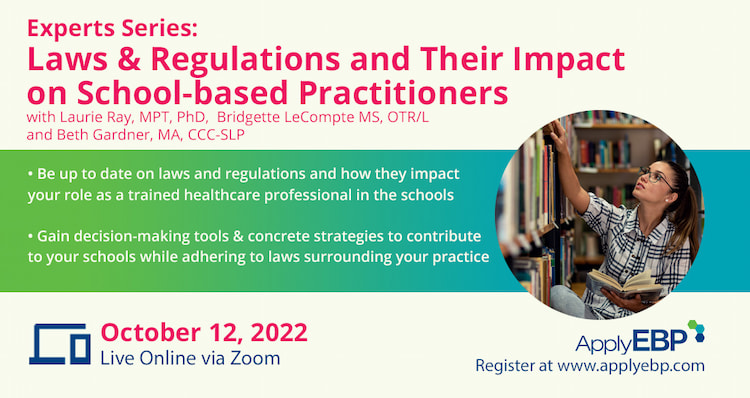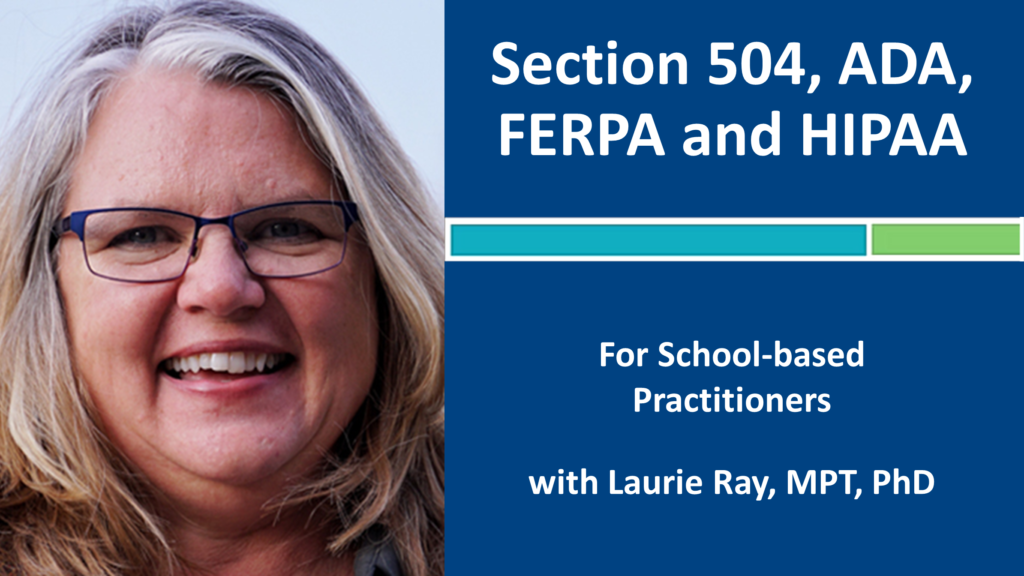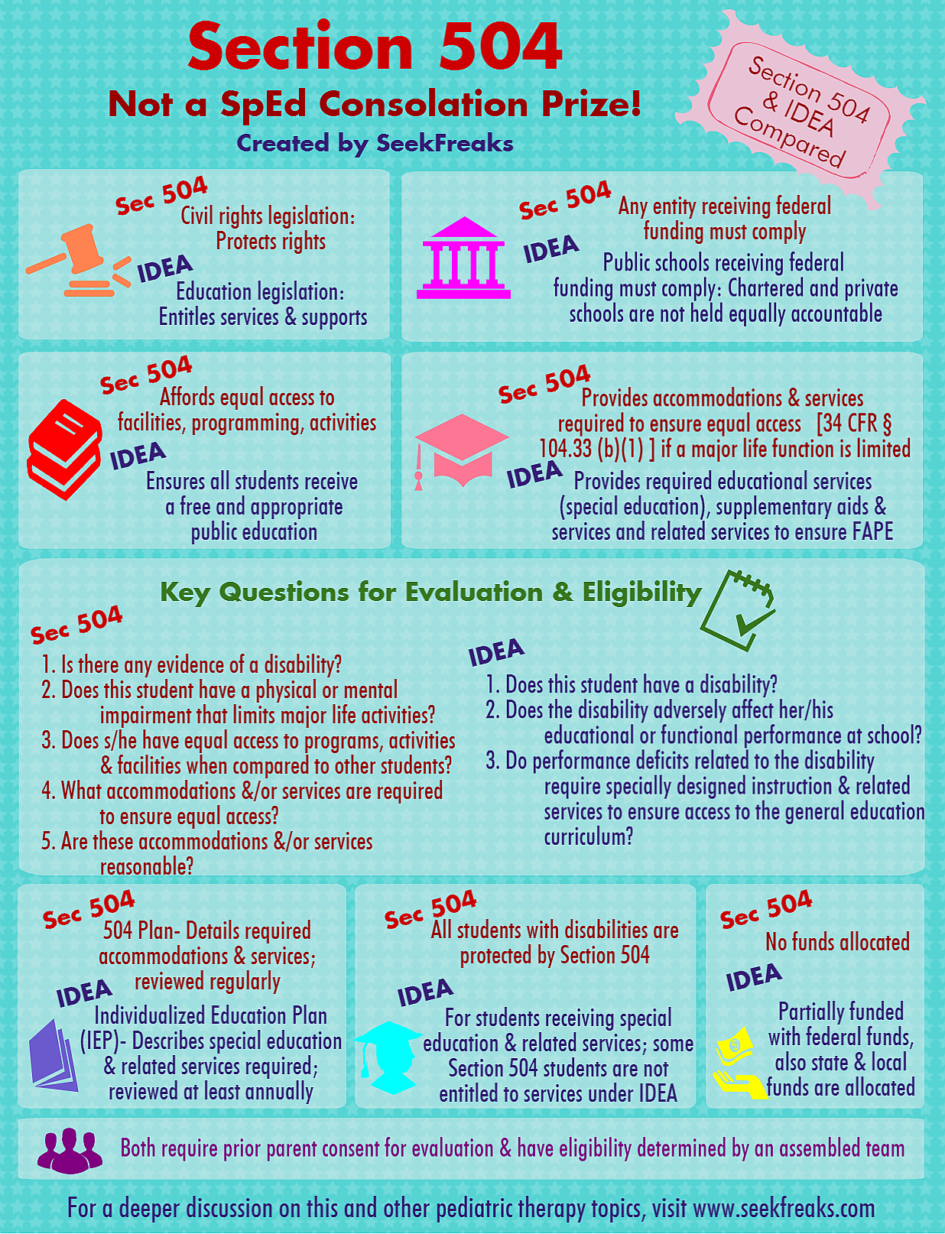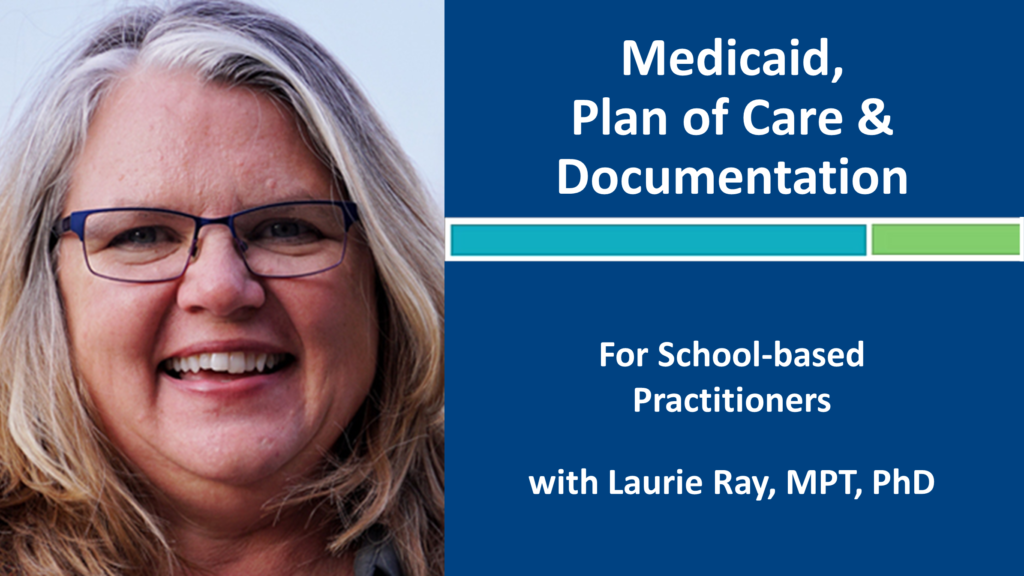Written by Laurie Ray, MPT, PhD, who has over 18 years of experience in school-based practice and is a state-level PT consultant for public schools. She also consults for Medicaid and Adapted Physical Education for her state and is an Associate Professor at UNC-Chapel Hill. Laurie also teaches continuing education via Apply EBP. More about these courses after the article below.



[smbtoolbar]
Section 504 of the Rehabilitation Act of 1973 29 USC § 794 and 34 CFR § 104.4
Often, there is great confusion between the legal requirements of Section 504 and IDEA in our public schools this posting hopes to clarify the requirements and features of each law. It is helpful to understand the differences between these laws as a starting point. The chart below outlines marked differences, nuanced difference and similarities.
|
Section 504 |
IDEA |
| Civil rights legislation: Protects rights | Education legislation: Entitles services & supports |
| Any entity receiving federal funding must comply | Public schools receiving federal funding must comply: Chartered and private schools are not held equally accountable |
| Affords equal access to facilities, programming, activities | Ensures all students receive a free and appropriate public education (FAPE) |
| All students with disabilities are protected under Section 504; broad assessment of disability & requirement of equal access/level playing field | Eligibility for services & supports determined through 14 educational categories & need for specially designed instruction |
| Section 504 Coordinator | Special Education/Exceptional Children Program Director |
| Provides accommodations & services required to ensure equal access [34 CFR § 104.33 (b)(1) ] if a major life function is limited | Provides required educational services (special education), supplementary aids & services and related services to ensure FAPE |
| Eligibility based on an evaluation (separate evaluation process from IDEA) to reveal substantial limitations of major life function(s) due to physical or mental impairment(s) | Eligibility based on evaluation to determine disability category (14), how the disability effects the student’s education and if specially designed instruction & related services are required |
| Key Questions for Evaluation & Eligibility:
1. Is there any evidence of a disability? 2. Does this student have a physical or mental impairment that limits major life activities? 3. Does s/he have equal access to programs, activities & facilities when compared to other students? 4. What accommodations &/or services are required to ensure equal access? 5. Are these accommodations &/or services reasonable? |
Key Questions for Evaluation and Eligibility:
1. Does this student have a disability? 2. Does the disability adversely affect her/his educational or functional performance at school? 3. Do performance deficits related to the disability require specially designed instruction & related services to ensure access to the general education curriculum? |
| Both require prior parent consent for evaluation & have eligibility determined by an assembled team | |
| All students with disabilities are protected by Section 504 | For students receiving special education & related services; some Section 504 students are not entitled to services under IDEA |
| 504 Plan- Details required accommodations & services; reviewed regularly | Individualized Education Plan (IEP)- Describes special education & related services required; reviewed at least annually |
| No funds allocated | Partially funded with federal funds, also state & local funds are allocated |
Both laws govern public schools and related programs and operate in parallel; one does not supercede or replace the other. The purpose of each law is different. IDEA is an entitlement, an educational law which ensures all students receive a free and appropriate education (FAPE). Section 504 is part of a law that protects Civil Rights for people with disabilities. IDEA is enacted in public schools which receive federal funding, private and charter schools have some responsibilities under IDEA (e.g. child find) but ultimately are not held to providing required educational supports and services for all students as are our public schools. Any entity that receives federal funding is required to comply with Section 504. This includes public buildings and programs (e.g. court houses, post offices, public parks, recreation programs).
Both laws require eligibility be decided by a team based on evaluation. However, specificity of how eligibility is determined, how teams are comprised, frequency of review and who administrates these plans are not as clearly stated in the Section 504 regulations. Consequently, our schools have often employed Section 504 as a consolation prize or step down from Special Education/IDEA services. This is not correct. Section 504 plans should have teams assembled who are equipped to determine needed accommodations & services, how they will be provided and when plan review is needed. Both plans are based on evaluation to provide teams student performance data to drive eligibility and planning. On the other hand, the questions posed to the evaluation are different. IDEA eligibility is determined by the ascertation of a disability as defined by IDEA, how the disability affects educational and functional performance and if these affects will not allow the student to access the general education curriculum but that an individualized curriculum/specially designed instruction are required. A somewhat different assessment is required by Section 504. Evaluation must reveal a more broadly defined disability and if this disability substantially limits a major life activity.
One of the greatest differences between IDEA and Section 504 is funding. IDEA is partially funded federally, Section 504 has no funding allotted specifically for these evaluations and services. This does not relieve any entity receiving federal fund from Section 504 responsibilities! Additionally, related service providers paid with federal IDEA funds must be working exclusively with students identified as requiring special education. Some districts use some state or local funds to pay a portion of the providers’ salaries to allow for that therapist to participate in Section 504 evaluation and services and other general education initiatives, such as Multiple Tiered Systems of Support or Responsiveness to Interventions.
Another requirement of Section 504 is that the accommodations and services be reasonable. This can be a difficult determination. The courts have considered available budgets to assess whether a specific service or modification is reasonable. Here are some examples of more common 504 accommodations and services:
- Modify assignments and tests
- Provide an extra set of textbooks for home
- Adjust child’s seating
- Use of study guides, organizing tools
- Modify recess or physical education
- Alternate classroom location
- Provide a peer tutor/helper
- Training for a student for fall prevention, transfers, use of assistive technology, etc.
In 2008, Congress passed amendments to Section 504. Congress amended Section 504 because Supreme Court decisions were seen as interpreting the definition of disability too narrowly, for both Americans with Disability Act and included the Rehabilitation Act of 1973, Section 504 in this legislation. Court cases were seen as requiring a higher legal burden and limited scope of these protections that were not intended by Congress. “Congress intends that the scope of the Americans with Disabilities Act be broad and inclusive. It is the intent of the legislation to establish a degree of functional limitation required for an impairment to constitute a disability that is consistent with what Congress originally intended . . .”
Disability. Under 504, the definition of disability [at 34 C.F.R. 104.3(j)(2)(i)] should be broadly determined and there should not be extensive evaluation required to decide if a student has a disability.
- “An impairment need not prevent or severely or significantly restrict a major life activity to be considered substantially limiting.”.
- “A physical or mental impairment that substantially limits a major life activity,” should be determined without employing any treatment, intervention or mitigating measures (e.g. medication, orthotics, assistive devices, prosthetic devices, or learned behavioral or adaptive neurological modifications that an individual may use to eliminate or reduce the effects of an impairment). When deciding if there is a ‘substantial limitation’ these measure cannot be considered.
- If an impairment is episodic or in remission, the determination must be made when in an active phase. For example, a student with bipolar disorder would be covered if substantial limitation of a major life activity (e.g., thinking, concentrating, neurological function, or brain function) was determined during manic or depressive episodes versus when functioning optimally.
- A student should not be determined to have a disability if the impairment is both temporary (< 6 months) and minor in effect.
- Section 504 excludes protection from, any student who is currently engaging in the illegal use of drugs. (There are exceptions for persons in rehabilitation programs who are no longer engaging in the illegal use of drugs). Section 504’s definition of a student with a disability does not exclude users of alcohol.
Major Life Activity. The Amendments Act contains lists of major life activities [at 28 C.F.R. § 35.104; 34 C.F.R. § 104.3(j)(2)(ii)], which are not considered complete or final, other activities can be considered by 504 teams. Examples of major life activities now include, but are not limited to:
- caring for oneself
- working
- seeing
- hearing
- eating
- sleeping
- walking
- standing
- lifting
- bending
- speaking
- breathing
- learning
- reading
- concentrating
- thinking
- communicating
- performing manual task
Nothing in the ADA or Section 504 limits coverage or protection to those whose impairments concern learning. Learning is just one of a number of major life activities that should be considered in determining whether a student has a disability within the meaning of those laws. Major bodily functions are also considered major life activities, such as: functions of the immune system, normal cell growth, and digestive, bowel, bladder, neurological, brain, respiratory, circulatory, endocrine, and reproductive functions. See Amendments Act § 4(a) (42 U.S.C. § 12102).
~~~~~~~~~~ 0 ~~~~~~~~~~
For further information about the Amendments Act and Section 504, refer to “Protecting Students With Disabilities: Frequently Asked Questions About Section 504 and the Education of Children with Disabilities,” at http://www.ed.gov/about/offices/list/ocr/504faq.html
The Office of Civil Rights offers technical assistance to complying with Section 504, Title II, and the other civil rights laws. http://wdcrobcolp01.ed.gov/CFAPPS/OCR/contactus.cfm for contact information for the OCR enforcement office that serves your state or area.
Additional information about OCR’s case processing can be found in the OCR Case Processing Manual, available on our website at http://www2.ed.gov/about/offices/list/ocr/docs/ocrcpm.html Title II complaints against public entities, including school districts, may also be filed with DOJ. Additional information about filing a Title II complaint with DOJ, technical assistance and guidance can be found on the DOJ’s website at www.ada.gov
~~~~~~~~~~ 0 ~~~~~~~~~~
References:
- Section 504 of the Rehabilitation Act of 1973 29 USC § 794 and 34 CFR § 104.4
- ADA Amendments Act of 2008, Pub. L. No. 110-325, 122 Stat. 3553 (2008).
- 154 Cong. Rec. S8342, S8345 (daily ed. Sept. 11, 2008) (statement of the Managers).
- See Amendments Act, supra note 3, at § 7 (codified as amended at 42 U.S.C. § 12102).
- 154 Cong. Rec. S8342, 8346 (daily ed. Sept. 11, 2008) (statement of Managers).
- Section 504 34 C.F.R. pt. 104, App. A § 104.33 at 407 (2010)
- Individuals with Disabilities Education Improvement Act of 2004. PL 108-446, 120 U.S.C. http://idea.ed.gov/
- 154 Cong. Rec. S8342, 8346 (daily ed. Sept. 11, 2008) (statement of the Managers to Accompany S. 3406, The Americans with Disabilities Act Amendments Act of 2008).
Join author, Laurie Ray, and her colleagues in the following continuing education courses…













March 5, 2017 at 9:59 am
This is a great comparison for public education services documentation and qualifications. But what happens to people with disabilities after graduation? Well, post secondary education entities are different. As therapists involved in transition planning, it is important to educate the students about differences in public education and college. Responsibility for declaration of disability lies with the enrolled student. In order to receive accommodations, the student must meet with the office if disability services and determine what is appropriate. Colleges do not modify curriculum, they only are required to provide access to the materials, experience and environment. The student can use the IEP or 504 to support their needs as part of their declaration of disability. So as service providers do your best to educate and advocate for your students and their families on how to use the laws during transition.
March 6, 2017 at 9:39 am
Great points, Becca! Nothing ends with school…we should be working towards transition early and often. Self-determination is critical for all students but specific skills in advocacy and networking are necessary for students moving next to college and/or work.
Thank you for your insight and this thoughtful comment!
August 24, 2017 at 10:19 am
Note the ‘P’ in IEP stands for ‘Program’, not Plan – it’s common for people to interchange the two terms, but there’s a technical difference.
P.S. LOVE everything about this site!!!
March 26, 2019 at 4:29 pm
This is a great resource. I would like information on how to secure permission for use.